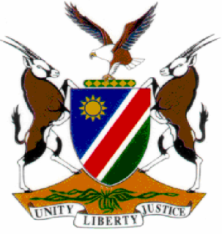
CASE NO.: CR13/2011
IN THE HIGH COURT OF NAMIBIA
HELD AT OSHAKATI
In the matter between:
THE STATE
and
MICHEAL UCHAM
CORAM: LIEBENBERG J & TOMMASI J
High Court Review ref No: 159/2010
Delivered on: 18 May 2011
REVIEW JUDGEMENT
TOMMASI J: [1] This matter came before me on automatic review. The accused was convicted of assault with the intent to do grievous bodily harm and was sentenced to a fine of N$1000.00 (One thousand Namibian dollars) or ten (10) months imprisonment of which N$400.00 (Four hundred Namibian dollars) or four (4) months were suspended on the usual conditions.
[2] The accused was asked to plead to the following charge:
“That the accused is guilty of the crime of assault with intent to do grievous bodily harm in that on or about the 9 day Februay’10 and at or near Okiti Bar in Sesfontein in the district of Opuwo the said accused did wrongfully, unlawfully, indecently and lasciviously assault one Markus Hoêb and did then and there by hitting him with a fist and he lost a tooth and sustain back injuries”(my emphasis).
[3] Although the offence is correctly stated in the charge, the particulars thereof omitted the essential allegation that the accused assaulted the complainant with the intention to do grievous bodily harm. This error clearly crept in when the prosecutor used the wrong pro forma charge sheet. It is however quite strange that this was not detected when the charge was read to the accused. When the concerned magistrate was requested to respond to the difference between the charge sheet and the questions posed to the accused, she replied that the wording of the charge was wrong; that it was not a proper and correct charge; and that she failed to examine the charge.
[4] The accused pleaded guilty to the charge and after questioning was convicted of the offence of assault with the intention to do grievous bodily harm. The accused, during questioning in terms of section 112(1)(b) admitted that he hit the complainant with a fist on the mouth and he fell down. He knew that by using his fist that he may cause serious injuries or hurt the complainant. He personally did not see the injuries but did not dispute the fact that the complainant lost his tooth and sustained back injuries. No medical report was handed into evidence.
[5] Section 84 of the Criminal Procedure Act, 1977 (Act 51 of 1977) requires that the:
“charge shall set forth the relevant offence in such manner and with such particulars as to time and place at which the offence is alleged to have been, and the person, if any, against whom, … in respect of which the offence is alleged to have been committed, as may be reasonably sufficient to inform the accused of the nature of the charge”.
Section 88 of the Criminal Procedure however provides that the defects in a charge may be cured by evidence unless it was brought to the attention of the magistrate before judgment.
[6] The accused did not admit in clear terms that he had the intent to cause more than just superficial injuries to the complainant. An admission by the accused of dolus eventualis would have been sufficient. That would have been the case if the accused admitted that that he knew, at the time he had assaulted the complainant with the fist on his mouth, that he could inflict an injury such as the one actually suffered by the complainant and that the appreciation of such consequences notwithstanding, he deliberately proceeded to assault the complainant. The accused however only admitted that he knew that an assault on the face may cause serious injuries. This falls short of an admission that he had intent in the form of dolus eventualus.
[7] Without a clear and unequivocal admission the court has to infer from the evidence that the accused had the required intent to do more than just inflict superficial injuries. In S v THOMAS 2006 (1) NR 83 (HC), on page 84 C – E, the following was stated:
“While the court may usually infer an accused's state of mind from evidence about the nature of the weapon or instrument used, the degree of force used by the accused in wielding that instrument or weapon, the situation on the body where the assault was directed and the injuries actually sustained by the victim of the assault (see S v Mbelu 1966 (1) PH H176 (N)), the answers given by an accused in the course of a s 112(1)(b) inquiry do not constitute 'evidence' on oath from which such inferences may be drawn.”
[8] It is trite law that where an intent to do grievous bodily harm is alleged, the act must be charged as having been done wrongfully, unlawfully and with the intent in question. In R v HAKANE 1958 (2) SA 333 (O) it was held that where an indictment of ‘assault with intent to do grievous bodily harm' merely alleged that the accused had ‘assaulted the complainant by stabbing him once in the back with a knife, then and there and thereby inflicting certain wounds and injuries upon him' and failed to mention that the wound had been inflicted with intent to do serious injury. The charge was considered inadequate to disclose assault with the intent to do grievous bodily harm and on review the conviction was altered to one of common assault. In this instance the charge was equally inadequate to disclose assault with the intent to do grievous bodily harm and no evidence was presented to cure the defect.
[9] In the result the conviction of assault with the intent to do grievous bodily harm is substituted with one of common assault and the sentenced imposed is substituted with a fine of N$400.00 or four (4) months imprisonment.
_____________________
TOMMASI J
I concur
____________________
LIEBENBERG J